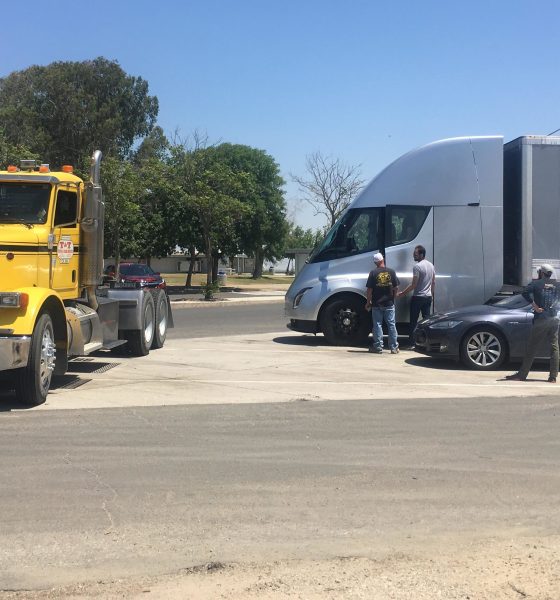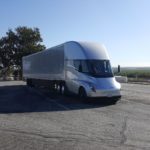

News
Tesla Semi with trailer spotted in run between Fremont and Palo Alto HQ
Tesla’s all-electric Semi was recently photographed by a Model 3 owner as it was traveling in CA-237 near Sunnyvale, CA, seemingly in the middle of a transport run between the company’s Fremont factory and its Palo Alto headquarters.
The latest image of the Tesla Semi was shared by Model 3 owner and r/TeslaMotors subreddit member u/AMG76, who stated that the picture was taken just this past weekend. This was not the first time that the Semi was spotted in the same area, however. Back in January, the black matte Tesla Semi was sighted accelerating in Elko Drive, Sunnyvale, CA.
Unlike the January Sunnyvale sighting, the Tesla Semi was hauling a trailer this time around. Apart from this, the silver Semi’s rear wheels in the photograph were also fitted with covers that are reminiscent of the Model 3’s Aero Wheels.
Tesla initially announced its plans to become the electric long-hauler’s first customer last year. During a talk in the Netherlands, Tesla VP of Truck programs Jerome Guillen stated that the massive electric vehicles would be used to transport components between Tesla’s factories in Fremont and Nevada.
“Tesla will be the first customer for its own truck. So we will use our own trucks to carry cargo in the US between our different facilities. We have (an) assembly factory in California, we have a battery factory in Nevada, so we’ll use our truck to carry things in between,” the Tesla executive said.
Back in March, Elon Musk proved Guillen’s statements right. In a series of posts on social media, Musk revealed that the two electric trucks would be transporting battery packs manufactured in Gigafactory 1 to the Fremont facility. During Musk’s announcement, the silver Semi, the company’s long-range hauler, as well as the smaller matte black were both deployed for the 250-mile transport run between the two factories.
- A photograph of the Tesla Semi as shared by Jerome Guillen, VP of Truck and Programs at Tesla Motors. [Credit: Jerome Guillen/LinkedIn]
- A photograph of the Tesla Semi as shared by Jerome Guillen, VP of Truck and Programs at Tesla Motors. [Credit: Jerome Guillen/LinkedIn]
The two electric trucks have been spotted in the Fremont, CA – Sparks, NV route multiple times since then. Even Guillen has begun posting photos of the Tesla Semi in his personal LinkedIn account, the most recent of which featured the electric truck “asking” a diesel-powered semi to get out of its way.
Apart from doing transport runs between Fremont and Nevada, or Palo Alto and Fremont, for that matter, the Tesla Semi has also been spotted visiting some of its biggest buyers during the past few months. The silver Tesla Semi, for one, was sighted in the Anheuser-Busch Brewery in St. Louis, MO, and in the Dallas, TX area, where it was demoed for PepsiCo employees. The black matte Semi, on the other hand, was spotted being transported on the back of a truck at a highway near Des Moines, IA, close to the headquarters of Ruan Transportation Management Systems.
Production of the Tesla Semi is expected to begin sometime next year. For now, Tesla is currently working with some of its largest customers in designing and building ultra-high-powered charging stations for the vehicles. Dubbed as the Megachargers, the Tesla Semi charging stations will be installed at key locations that are frequently traveled by fleet operators and close enough so that electric truck drivers could travel between facilities without needing to recharge each time they load and unload their cargo.

Elon Musk
Elon Musk and Tesla AI Director share insights after empty driver seat Robotaxi rides
The executives’ unoccupied tests hint at the rapid progress of Tesla’s unsupervised Robotaxi efforts.

Tesla CEO Elon Musk and AI Director Ashok Elluswamy celebrated Christmas Eve by sharing personal experiences with Robotaxi vehicles that had no safety monitor or occupant in the driver’s seat. Musk described the system’s “perfect driving” around Austin, while Elluswamy posted video from the back seat, calling it “an amazing experience.”
The executives’ unoccupied tests hint at the rapid progress of Tesla’s unsupervised Robotaxi efforts.
Elon and Ashok’s firsthand Robotaxi insights
Prior to Musk and the Tesla AI Director’s posts, sightings of unmanned Teslas navigating public roads were widely shared on social media. One such vehicle was spotted in Austin, Texas, which Elon Musk acknowleged by stating that “Testing is underway with no occupants in the car.”
Based on his Christmas Eve post, Musk seemed to have tested an unmanned Tesla himself. “A Tesla with no safety monitor in the car and me sitting in the passenger seat took me all around Austin on Sunday with perfect driving,” Musk wrote in his post.
Elluswamy responded with a 2-minute video showing himself in the rear of an unmanned Tesla. The video featured the vehicle’s empty front seats, as well as its smooth handling through real-world traffic. He captioned his video with the words, “It’s an amazing experience!”
Towards Unsupervised operations
During an xAI Hackathon earlier this month, Elon Musk mentioned that Tesla owed be removing Safety Monitors from its Robotaxis in Austin in just three weeks. “Unsupervised is pretty much solved at this point. So there will be Tesla Robotaxis operating in Austin with no one in them. Not even anyone in the passenger seat in about three weeks,” he said. Musk echoed similar estimates at the 2025 Annual Shareholder Meeting and the Q3 2025 earnings call.
Considering the insights that were posted Musk and Elluswamy, it does appear that Tesla is working hard towards operating its Robotaxis with no safety monitors. This is quite impressive considering that the service was launched just earlier this year.
Elon Musk
Starlink passes 9 million active customers just weeks after hitting 8 million
The milestone highlights the accelerating growth of Starlink, which has now been adding over 20,000 new users per day.

SpaceX’s Starlink satellite internet service has continued its rapid global expansion, surpassing 9 million active customers just weeks after crossing the 8 million mark.
The milestone highlights the accelerating growth of Starlink, which has now been adding over 20,000 new users per day.
9 million customers
In a post on X, SpaceX stated that Starlink now serves over 9 million active users across 155 countries, territories, and markets. The company reached 8 million customers in early November, meaning it added roughly 1 million subscribers in under seven weeks, or about 21,275 new users on average per day.
“Starlink is connecting more than 9M active customers with high-speed internet across 155 countries, territories, and many other markets,” Starlink wrote in a post on its official X account. SpaceX President Gwynne Shotwell also celebrated the milestone on X. “A huge thank you to all of our customers and congrats to the Starlink team for such an incredible product,” she wrote.
That growth rate reflects both rising demand for broadband in underserved regions and Starlink’s expanding satellite constellation, which now includes more than 9,000 low-Earth-orbit satellites designed to deliver high-speed, low-latency internet worldwide.
Starlink’s momentum
Starlink’s momentum has been building up. SpaceX reported 4.6 million Starlink customers in December 2024, followed by 7 million by August 2025, and 8 million customers in November. Independent data also suggests Starlink usage is rising sharply, with Cloudflare reporting that global web traffic from Starlink users more than doubled in 2025, as noted in an Insider report.
Starlink’s momentum is increasingly tied to SpaceX’s broader financial outlook. Elon Musk has said the satellite network is “by far” the company’s largest revenue driver, and reports suggest SpaceX may be positioning itself for an initial public offering as soon as next year, with valuations estimated as high as $1.5 trillion. Musk has also suggested in the past that Starlink could have its own IPO in the future.
News
NVIDIA Director of Robotics: Tesla FSD v14 is the first AI to pass the “Physical Turing Test”
After testing FSD v14, Fan stated that his experience with FSD felt magical at first, but it soon started to feel like a routine.

NVIDIA Director of Robotics Jim Fan has praised Tesla’s Full Self-Driving (Supervised) v14 as the first AI to pass what he described as a “Physical Turing Test.”
After testing FSD v14, Fan stated that his experience with FSD felt magical at first, but it soon started to feel like a routine. And just like smartphones today, removing it now would “actively hurt.”
Jim Fan’s hands-on FSD v14 impressions
Fan, a leading researcher in embodied AI who is currently solving Physical AI at NVIDIA and spearheading the company’s Project GR00T initiative, noted that he actually was late to the Tesla game. He was, however, one of the first to try out FSD v14.
“I was very late to own a Tesla but among the earliest to try out FSD v14. It’s perhaps the first time I experience an AI that passes the Physical Turing Test: after a long day at work, you press a button, lay back, and couldn’t tell if a neural net or a human drove you home,” Fan wrote in a post on X.
Fan added: “Despite knowing exactly how robot learning works, I still find it magical watching the steering wheel turn by itself. First it feels surreal, next it becomes routine. Then, like the smartphone, taking it away actively hurts. This is how humanity gets rewired and glued to god-like technologies.”
The Physical Turing Test
The original Turing Test was conceived by Alan Turing in 1950, and it was aimed at determining if a machine could exhibit behavior that is equivalent to or indistinguishable from a human. By focusing on text-based conversations, the original Turing Test set a high bar for natural language processing and machine learning.
This test has been passed by today’s large language models. However, the capability to converse in a humanlike manner is a completely different challenge from performing real-world problem-solving or physical interactions. Thus, Fan introduced the Physical Turing Test, which challenges AI systems to demonstrate intelligence through physical actions.
Based on Fan’s comments, Tesla has demonstrated these intelligent physical actions with FSD v14. Elon Musk agreed with the NVIDIA executive, stating in a post on X that with FSD v14, “you can sense the sentience maturing.” Musk also praised Tesla AI, calling it the best “real-world AI” today.











